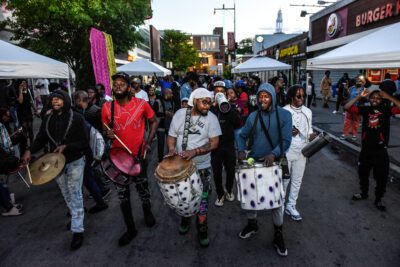Suraj Patel Breaks Tradition With Political Campaign
“One consultant even told me that if you challenge Carolyn Maloney, you’ll never have lunch in this town again,” exclaims Suraj Patel with a half laugh from his Astor Place campaign headquarters. The former cocktail bar is decked out in Patel’s pale pink and blue campaign posters, signs emblazoned with slogans such as “Competition fuels Democracy” and filled with youthful staffers and volunteers. The 34-congressional hopeful for District-12 indeed has a tough task in unseating Congresswoman Maloney, who has held office for 13 terms – or since 1993. But Patel is counting on a groundswell of activism and a newly invigorated population after Trump’s election.
Patel was born in Mississippi and raised in Indiana, Patel has been an East Village resident since enrolling at NYU Law 12 years ago. The President of his family’s hospitality company and an adjunct professor at Stern lecturing on business ethics, he joined the Obama’s campaign in 2008 for his foray into professional politics and worked for the White House during both of the President’s terms. Against a veteran politician such as Maloney, Patel has employed strategies and an approach from the business world.
“I’d never beat such a traditional incumbent by being traditional,” he reasons. Eschewing conventional political wisdom that relies on party voter files and heavily prioritizes known past voters, Patel and his campaign are looking to build new voter profiles – a process akin to “customer discovery.” He continues, “no-one is looking for the attributes of who could be a potential customer and bringing them into the fold.” Politically, it’s a much bigger and more fundamental goal of expanding the electoral map, and for Patel, particularly amongst younger voters where turnout is particularly low, “I think that people don’t vote because they’re not asked to vote. It’s that simple. They’re not asked to vote. On an off year many people don’t even know there’s an election because they’re not getting the information.”
New York’s 12th district is one of the most affluent – covering a large swath of eastern Manhattan (including segments of the Lower East Side all the way to Central Park), Williamsburg, Greenpoint, Long Island City, Roosevelt Island and parts of Astoria – and the median age is 36, meaning the potential of younger voters to decide elections is pronounced.
Studying the success of digital disrupters such as Glossier and Casper, 70% of the campaign’s ad spend is digital. It’s also cultivated a brand-sensibility and visual language familiar to a younger demographic. Content and design is all created in-house, from campaign “swag” of stickers, pins, Rocky Horror Show inspired T-shirts and playful totes to the online videos posted on the campaign website featuring the candidate in front of a background of vivid color gradients recalling Instagram’s logo.
It’s not all digital. Courting the millennial vote has also brought the campaign to boutique fitness classes such as Flywheel, SoulCycle and Mile High Run Club (on this Patel groans, “I hate running, its miserable… but they made me.”) “Maybe if we can’t get a bunch of young people to show up to a church basement to listen to someone talk for 45 minutes and do a Q&A….What’s their town hall setting? Well in New York City, for lack of a better example, our church is fitness class. We’re just trying to go anywhere that people gather.”
Across the city, 50 coffee carts distributed 200,000 cups with Patel’s face along with information about how to register to vote. On the advice of the CEO of Harry’s, who pointed to mail as one of the most effective customer acquisition tools, the campaign sent out thousands of mailers across the city to a wide range of registered democrats, not just the established set who had voted in the past 3 elections, along with an absentee ballot request form and a digital activation to receive free campaign merchandise.
Given the tenor of increasing outrage on most our social media and the proliferation of marches bringing politically informed and passionate teens to the forefront, it seems Patel’s emphasis on new and younger voters may pay off. He smiles more broadly, “We’ll see, we’ll see. I haven’t seen a campaign like mine but if we can change the underlying demographics of the electorate that shows up by 5 points to be younger, more diverse, more progressive, that’s the paradigm shift Democrats need across the country.
You might also like 


























